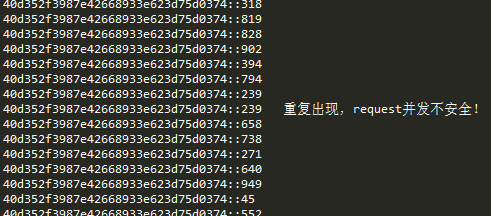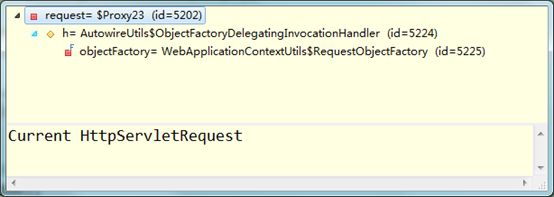Spring中獲取request的幾種方法,及其線程安全性分析
前言
本文將介紹在Spring MVC開發的web系統中,獲取request對象的幾種方法,并討論其線程安全性。
目錄
- 概述
- 如何測試線程安全性
- 方法1:Controller中加參數
- 方法2:自動注入
- 方法3:基類中自動注入
- 方法4:手動調用
- 方法5:@ModelAttribute方法
- 總結
概述
在使用Spring MVC開發Web系統時,經常需要在處理請求時使用request對象,比如獲取客戶端ip地址、請求的url、header中的屬性(如cookie、授權信息)、body中的數據等。由于在Spring MVC中,處理請求的Controller、Service等對象都是單例的,因此獲取request對象時最需要注意的問題,便是request對象是否是線程安全的:當有大量并發請求時,能否保證不同請求/線程中使用不同的request對象。
這里還有一個問題需要注意:前面所說的“在處理請求時”使用request對象,究竟是在哪里使用呢?考慮到獲取request對象的方法有微小的不同,大體可以分為兩類:
- 在Spring的Bean中使用request對象:既包括Controller、Service、Repository等MVC的Bean,也包括了Component等普通的Spring Bean。為了方便說明,后文中Spring中的Bean一律簡稱為Bean。
- 在非Bean中使用request對象:如普通的Java對象的方法中使用,或在類的靜態方法中使用。
此外,本文討論是圍繞代表請求的request對象展開的,但所用方法同樣適用于response對象、InputStream/Reader、OutputStream/ Writer等;其中InputStream/Reader可以讀取請求中的數據,OutputStream/ Writer可以向響應寫入數據。
***,獲取request對象的方法與Spring及MVC的版本也有關系;本文基于Spring4進行討論,且所做的實驗都是使用4.1.1版本。
如何測試線程安全性
既然request對象的線程安全問題需要特別關注,為了便于后面的討論,下面先說明如何測試request對象是否是線程安全的。
測試的基本思路,是模擬客戶端大量并發請求,然后在服務器判斷這些請求是否使用了相同的request對象。
判斷request對象是否相同,最直觀的方式是打印出request對象的地址,如果相同則說明使用了相同的對象。然而,在幾乎所有web服務器的實現中,都使用了線程池,這樣就導致先后到達的兩個請求,可能由同一個線程處理:在前一個請求處理完成后,線程池收回該線程,并將該線程重新分配給了后面的請求。而在同一線程中,使用的request對象很可能是同一個(地址相同,屬性不同)。因此即便是對于線程安全的方法,不同的請求使用的request對象地址也可能相同。
為了避免這個問題,一種方法是在請求處理過程中使線程休眠幾秒,這樣可以讓每個線程工作的時間足夠長,從而避免同一個線程分配給不同的請求;另一種方法,是使用request的其他屬性(如參數、header、body等)作為request是否線程安全的依據,因為即便不同的請求先后使用了同一個線程(request對象地址也相同),只要使用不同的屬性分別構造了兩次request對象,那么request對象的使用就是線程安全的。本文使用第二種方法進行測試。
客戶端測試代碼如下(創建1000個線程分別發送請求):
- public class Test {
- public static void main(String[] args) throws Exception {
- String prefix = UUID.randomUUID().toString().replaceAll("-", "") + "::";
- for (int i = 0; i < 1000; i++) {
- final String value = prefix + i;
- new Thread() {
- @Override
- public void run() {
- try {
- CloseableHttpClient httpClient = HttpClients.createDefault();
- HttpGet httpGet = new HttpGet("http://localhost:8080/test?key=" + value);
- httpClient.execute(httpGet);
- httpClient.close();
- } catch (IOException e) {
- e.printStackTrace();
- }
- }
- }.start();
- }
- }
- }
服務器中Controller代碼如下(暫時省略了獲取request對象的代碼):
- @Controller
- public class TestController {
- // 存儲已有參數,用于判斷參數是否重復,從而判斷線程是否安全
- public static Set<String> set = new ConcurrentSkipListSet<>();
- @RequestMapping("/test")
- public void test() throws InterruptedException {
- // …………………………通過某種方式獲得了request對象………………………………
- // 判斷線程安全
- String value = request.getParameter("key");
- if (set.contains(value)) {
- System.out.println(value + "\t重復出現,request并發不安全!");
- } else {
- System.out.println(value);
- set.add(value);
- }
- // 模擬程序執行了一段時間
- Thread.sleep(1000);
- }
- }
補充:上述代碼原使用HashSet來判斷value是否重復,經網友批評指正,使用線程不安全的集合類驗證線程安全性是欠妥的,現已改為ConcurrentSkipListSet。
如果request對象線程安全,服務器中打印結果如下所示:

如果存在線程安全問題,服務器中打印結果可能如下所示:

如無特殊說明,本文后面的代碼中將省略掉測試代碼。
方法1:Controller中加參數
代碼示例
這種方法實現最簡單,直接上Controller代碼:
- @Controller
- public class TestController {
- @RequestMapping("/test")
- public void test(HttpServletRequest request) throws InterruptedException {
- // 模擬程序執行了一段時間
- Thread.sleep(1000);
- }
- }
該方法實現的原理是,在Controller方法開始處理請求時,Spring會將request對象賦值到方法參數中。除了request對象,可以通過這種方法獲取的參數還有很多,具體可以參見:https://docs.spring.io/spring/docs/current/spring-framework-reference/web.html#mvc-ann-methods
Controller中獲取request對象后,如果要在其他方法中(如service方法、工具類方法等)使用request對象,需要在調用這些方法時將request對象作為參數傳入。
線程安全性
測試結果:線程安全
分析:此時request對象是方法參數,相當于局部變量,毫無疑問是線程安全的。
優缺點
這種方法的主要缺點是request對象寫起來冗余太多,主要體現在兩點:
- 如果多個controller方法中都需要request對象,那么在每個方法中都需要添加一遍request參數
- request對象的獲取只能從controller開始,如果使用request對象的地方在函數調用層級比較深的地方,那么整個調用鏈上的所有方法都需要添加request參數
實際上,在整個請求處理的過程中,request對象是貫穿始終的;也就是說,除了定時器等特殊情況,request對象相當于線程內部的一個全局變量。而該方法,相當于將這個全局變量,傳來傳去。
方法2:自動注入
代碼示例
先上代碼:
- @Controller
- public class TestController{
- @Autowired
- private HttpServletRequest request; //自動注入request
- @RequestMapping("/test")
- public void test() throws InterruptedException{
- //模擬程序執行了一段時間
- Thread.sleep(1000);
- }
- }
線程安全性
測試結果:線程安全
分析:在Spring中,Controller的scope是singleton(單例),也就是說在整個web系統中,只有一個TestController;但是其中注入的request卻是線程安全的,原因在于:
使用這種方式,當Bean(本例的TestController)初始化時,Spring并沒有注入一個request對象,而是注入了一個代理(proxy);當Bean中需要使用request對象時,通過該代理獲取request對象。
下面通過具體的代碼對這一實現進行說明。
在上述代碼中加入斷點,查看request對象的屬性,如下圖所示:

在圖中可以看出,request實際上是一個代理:代理的實現參見AutowireUtils的內部類ObjectFactoryDelegatingInvocationHandler:
- /**
- * Reflective InvocationHandler for lazy access to the current target object.
- */
- @SuppressWarnings("serial")
- private static class ObjectFactoryDelegatingInvocationHandler implements InvocationHandler, Serializable {
- private final ObjectFactory<?> objectFactory;
- public ObjectFactoryDelegatingInvocationHandler(ObjectFactory<?> objectFactory) {
- this.objectFactory = objectFactory;
- }
- @Override
- public Object invoke(Object proxy, Method method, Object[] args) throws Throwable {
- // ……省略無關代碼
- try {
- return method.invoke(this.objectFactory.getObject(), args); // 代理實現核心代碼
- }
- catch (InvocationTargetException ex) {
- throw ex.getTargetException();
- }
- }
- }
也就是說,當我們調用request的方法method時,實際上是調用了由objectFactory.getObject()生成的對象的method方法;objectFactory.getObject()生成的對象才是真正的request對象。
繼續觀察上圖,發現objectFactory的類型為WebApplicationContextUtils的內部類RequestObjectFactory;而RequestObjectFactory代碼如下:
- /**
- * Factory that exposes the current request object on demand.
- */
- @SuppressWarnings("serial")
- private static class RequestObjectFactory implements ObjectFactory<ServletRequest>, Serializable {
- @Override
- public ServletRequest getObject() {
- return currentRequestAttributes().getRequest();
- }
- @Override
- public String toString() {
- return "Current HttpServletRequest";
- }
- }
其中,要獲得request對象需要先調用currentRequestAttributes()方法獲得RequestAttributes對象,該方法的實現如下:
- /**
- * Return the current RequestAttributes instance as ServletRequestAttributes.
- */
- private static ServletRequestAttributes currentRequestAttributes() {
- RequestAttributes requestAttr = RequestContextHolder.currentRequestAttributes();
- if (!(requestAttr instanceof ServletRequestAttributes)) {
- throw new IllegalStateException("Current request is not a servlet request");
- }
- return (ServletRequestAttributes) requestAttr;
- }
生成RequestAttributes對象的核心代碼在類RequestContextHolder中,其中相關代碼如下(省略了該類中的無關代碼):
- public abstract class RequestContextHolder {
- public static RequestAttributes currentRequestAttributes() throws IllegalStateException {
- RequestAttributes attributes = getRequestAttributes();
- // 此處省略不相關邏輯…………
- return attributes;
- }
- public static RequestAttributes getRequestAttributes() {
- RequestAttributes attributes = requestAttributesHolder.get();
- if (attributes == null) {
- attributes = inheritableRequestAttributesHolder.get();
- }
- return attributes;
- }
- private static final ThreadLocal<RequestAttributes> requestAttributesHolder =
- new NamedThreadLocal<RequestAttributes>("Request attributes");
- private static final ThreadLocal<RequestAttributes> inheritableRequestAttributesHolder =
- new NamedInheritableThreadLocal<RequestAttributes>("Request context");
- }
通過這段代碼可以看出,生成的RequestAttributes對象是線程局部變量(ThreadLocal),因此request對象也是線程局部變量;這就保證了request對象的線程安全性。
優缺點
該方法的主要優點:
- 注入不局限于Controller中:在方法1中,只能在Controller中加入request參數。而對于方法2,不僅可以在Controller中注入,還可以在任何Bean中注入,包括Service、Repository及普通的Bean。
- 注入的對象不限于request:除了注入request對象,該方法還可以注入其他scope為request或session的對象,如response對象、session對象等;并保證線程安全。
- 減少代碼冗余:只需要在需要request對象的Bean中注入request對象,便可以在該Bean的各個方法中使用,與方法1相比大大減少了代碼冗余。
但是,該方法也會存在代碼冗余。考慮這樣的場景:web系統中有很多controller,每個controller中都會使用request對象(這種場景實際上非常頻繁),這時就需要寫很多次注入request的代碼;如果還需要注入response,代碼就更繁瑣了。下面說明自動注入方法的改進方法,并分析其線程安全性及優缺點。
方法3:基類中自動注入
代碼示例
與方法2相比,將注入部分代碼放入到了基類中。
基類代碼:
- public class BaseController {
- @Autowired
- protected HttpServletRequest request;
- }
Controller代碼如下;這里列舉了BaseController的兩個派生類,由于此時測試代碼會有所不同,因此服務端測試代碼沒有省略;客戶端也需要進行相應的修改(同時向2個url發送大量并發請求)。
- @Controller
- public class TestController extends BaseController {
- // 存儲已有參數,用于判斷參數value是否重復,從而判斷線程是否安全
- public static Set<String> set = new ConcurrentSkipListSet<>();
- @RequestMapping("/test")
- public void test() throws InterruptedException {
- String value = request.getParameter("key");
- // 判斷線程安全
- if (set.contains(value)) {
- System.out.println(value + "\t重復出現,request并發不安全!");
- } else {
- System.out.println(value);
- set.add(value);
- }
- // 模擬程序執行了一段時間
- Thread.sleep(1000);
- }
- }
- @Controller
- public class Test2Controller extends BaseController {
- @RequestMapping("/test2")
- public void test2() throws InterruptedException {
- String value = request.getParameter("key");
- // 判斷線程安全(與TestController使用一個set進行判斷)
- if (TestController.set.contains(value)) {
- System.out.println(value + "\t重復出現,request并發不安全!");
- } else {
- System.out.println(value);
- TestController.set.add(value);
- }
- // 模擬程序執行了一段時間
- Thread.sleep(1000);
- }
- }
線程安全性
測試結果:線程安全
分析:在理解了方法2的線程安全性的基礎上,很容易理解方法3是線程安全的:當創建不同的派生類對象時,基類中的域(這里是注入的request)在不同的派生類對象中會占據不同的內存空間,也就是說將注入request的代碼放在基類中對線程安全性沒有任何影響;測試結果也證明了這一點。
優缺點
與方法2相比,避免了在不同的Controller中重復注入request;但是考慮到java只允許繼承一個基類,所以如果Controller需要繼承其他類時,該方法便不再好用。
無論是方法2和方法3,都只能在Bean中注入request;如果其他方法(如工具類中static方法)需要使用request對象,則需要在調用這些方法時將request參數傳遞進去。下面介紹的方法4,則可以直接在諸如工具類中的static方法中使用request對象(當然在各種Bean中也可以使用)。
方法4:手動調用
代碼示例
- @Controller
- public class TestController {
- @RequestMapping("/test")
- public void test() throws InterruptedException {
- HttpServletRequest request = ((ServletRequestAttributes) (RequestContextHolder.currentRequestAttributes())).getRequest();
- // 模擬程序執行了一段時間
- Thread.sleep(1000);
- }
- }
線程安全性
測試結果:線程安全
分析:該方法與方法2(自動注入)類似,只不過方法2中通過自動注入實現,本方法通過手動方法調用實現。因此本方法也是線程安全的。
優缺點
優點:可以在非Bean中直接獲取。缺點:如果使用的地方較多,代碼非常繁瑣;因此可以與其他方法配合使用。
方法5:@ModelAttribute方法
代碼示例
下面這種方法及其變種(變種:將request和bindRequest放在子類中)在網上經常見到:
- @Controller
- public class TestController {
- private HttpServletRequest request;
- @ModelAttribute
- public void bindRequest(HttpServletRequest request) {
- this.request = request;
- }
- @RequestMapping("/test")
- public void test() throws InterruptedException {
- // 模擬程序執行了一段時間
- Thread.sleep(1000);
- }
- }
線程安全性
測試結果:線程不安全
分析:@ModelAttribute注解用在Controller中修飾方法時,其作用是Controller中的每個@RequestMapping方法執行前,該方法都會執行。因此在本例中,bindRequest()的作用是在test()執行前為request對象賦值。雖然bindRequest()中的參數request本身是線程安全的,但由于TestController是單例的,request作為TestController的一個域,無法保證線程安全。
總結
綜上所述,Controller中加參數(方法1)、自動注入(方法2和方法3)、手動調用(方法4)都是線程安全的,都可以用來獲取request對象。如果系統中request對象使用較少,則使用哪種方式均可;如果使用較多,建議使用自動注入(方法2 和方法3)來減少代碼冗余。如果需要在非Bean中使用request對象,既可以在上層調用時通過參數傳入,也可以直接在方法中通過手動調用(方法4)獲得。
此外,本文在討論獲取request對象的方法時,重點討論該方法的線程安全性、代碼的繁瑣程度等;在實際的開發過程中,還必須考慮所在項目的規范、代碼維護等問題(此處感謝網友的批評指正)
參考文獻
- https://docs.spring.io/spring/docs/4.1.x/spring-framework-reference/html/beans.html#beans-factory-scopes-other-injection
- https://docs.spring.io/spring/docs/current/spring-framework-reference/web.html#mvc-ann-methods
- https://stackoverflow.com/questions/10541934/spring-aop-and-aspect-thread-safety-for-an-autowired-httpservletrequest-bean
- http://www.phpchina.com/portal.php?mod=view&aid=40966
- https://stackoverflow.com/questions/22674044/inject-httpservletrequest-into-controller
- https://stackoverflow.com/questions/3320674/spring-how-do-i-inject-an-httpservletrequest-into-a-request-scoped-bean
- https://my.oschina.net/sluggarddd/blog/678603?fromerr=XhvpvVTi
- https://stackoverflow.com/questions/8504258/spring-3-mvc-accessing-httprequest-from-controller






























